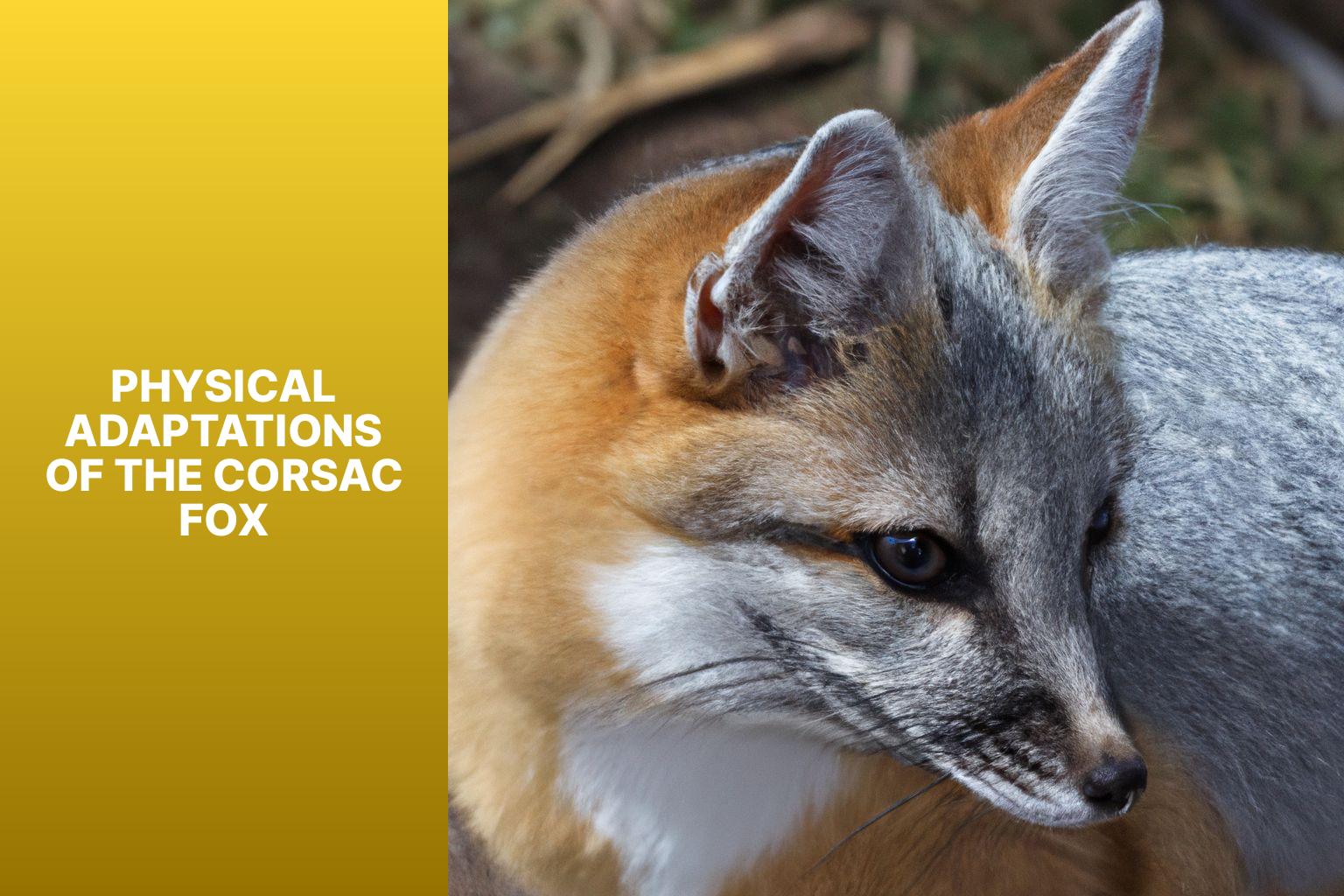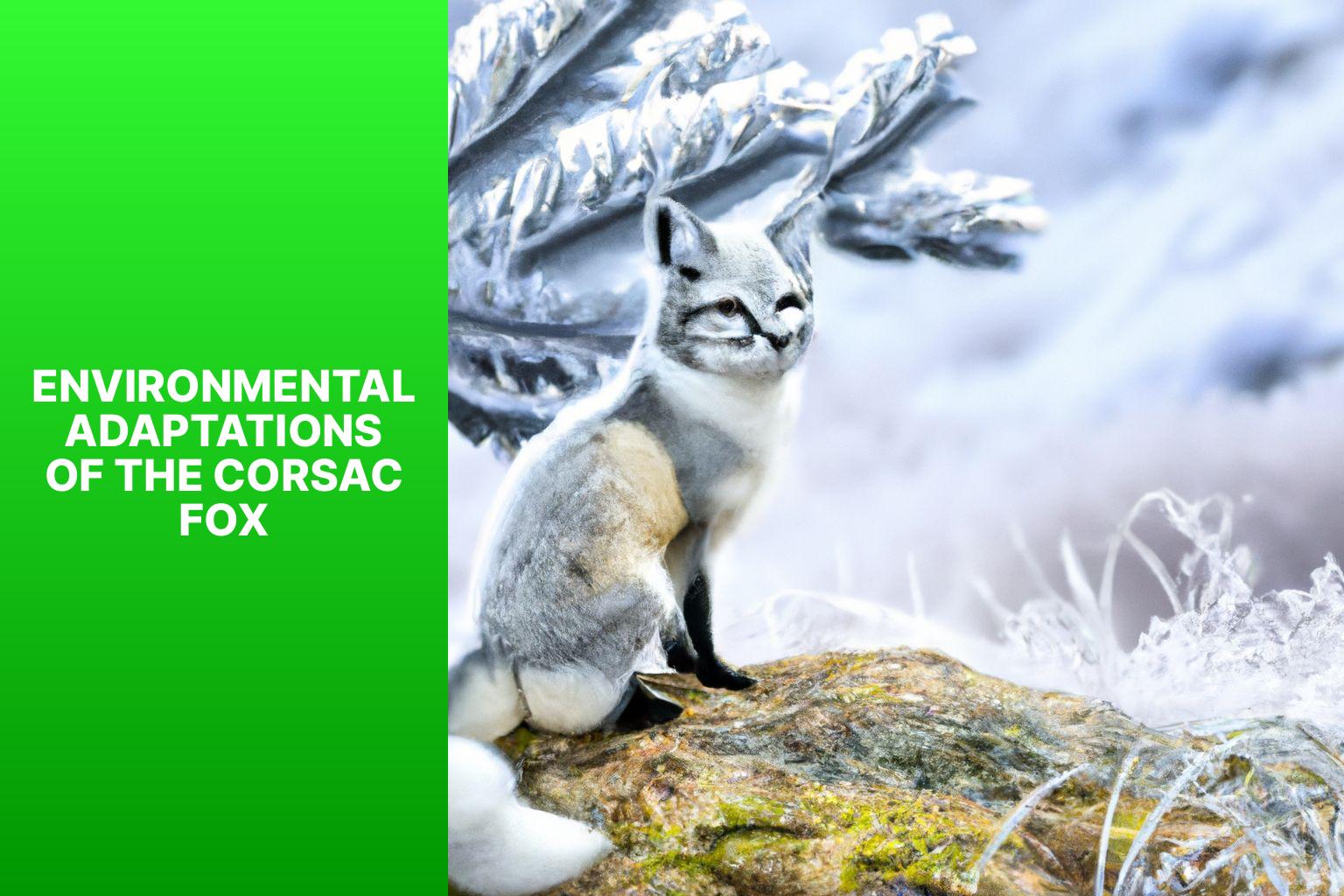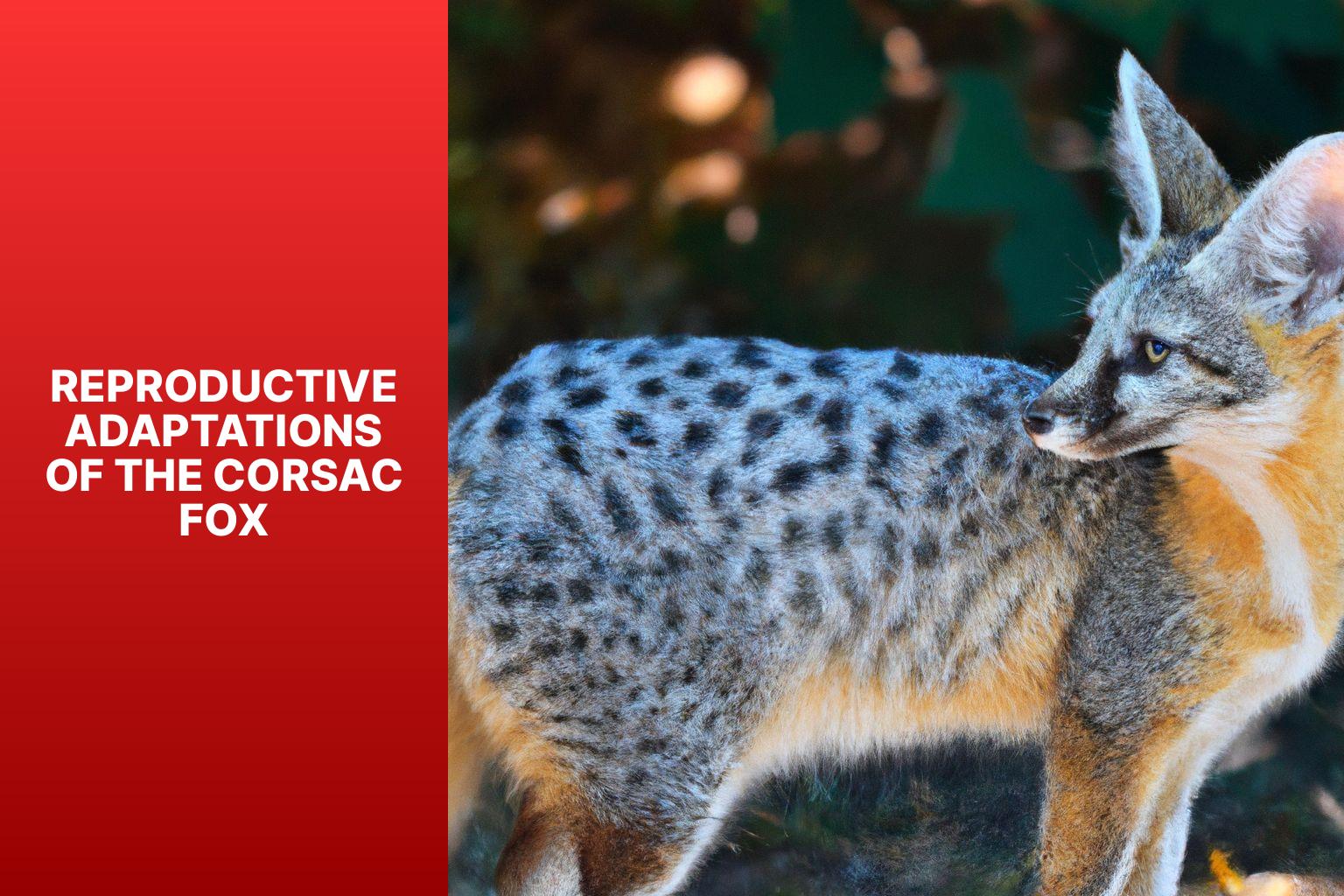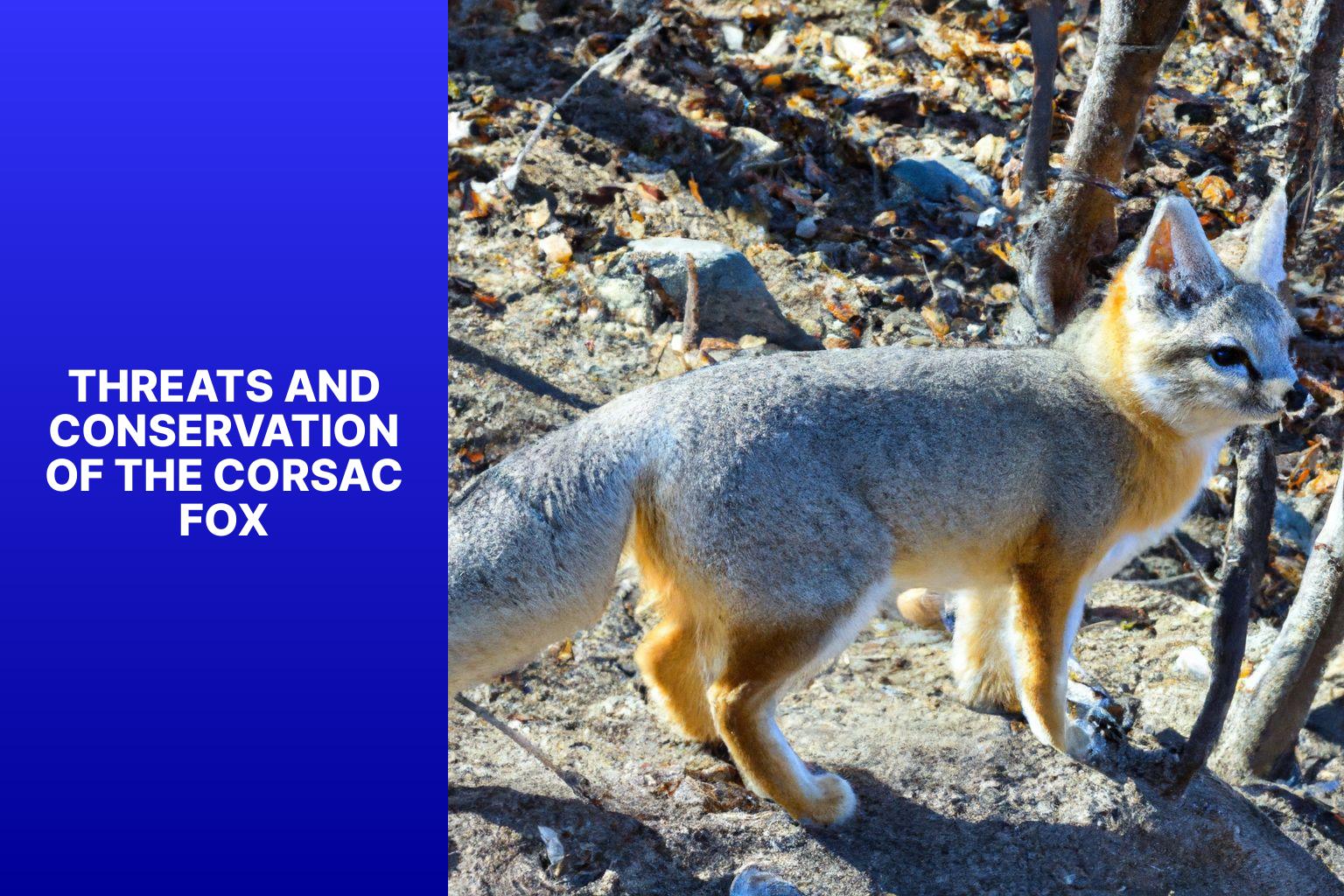The Corsac Fox, also known as the steppe fox or the sand fox, is a small fox species native to the arid regions of Central Asia. This article explores the various adaptations of the Corsac Fox that enable it to thrive in its unique environment and survive the challenges it faces. Understanding these adaptations provides insight into the fascinating ways in which this species has evolved to survive and thrive. The adaptations of the Corsac Fox can be categorized into physical, behavioral, dietary, environmental, and reproductive adaptations. This article will delve into each of these categories and shed light on the remarkable characteristics and strategies that allow the Corsac Fox to survive in its habitat.
Contents
- 1 Key takeaway:
- 2 Physical Adaptations of the Corsac Fox
- 3 Behavioral Adaptations of the Corsac Fox
- 4 Dietary Adaptations of the Corsac Fox
- 5 Environmental Adaptations of the Corsac Fox
- 6 Reproductive Adaptations of the Corsac Fox
- 7 Threats and Conservation of the Corsac Fox
- 8 Frequently Asked Questions
- 8.1 What is the scientific classification of the Corsac Fox?
- 8.2 What is the average size of a Corsac Fox?
- 8.3 What are the main adaptations of the Corsac Fox for its habitat?
- 8.4 What is the gestation period of the Corsac Fox?
- 8.5 What is the conservation status of the Corsac Fox?
- 8.6 What is the typical litter size of the Corsac Fox?
Key takeaway:
- Corsac fox adapts to its environment: The corsac fox has various physical, behavioral, dietary, environmental, and reproductive adaptations that help it survive in its natural habitat.
- Physical adaptations ensure survival: The corsac fox’s fur coat, body size and shape, and ears help it thrive in extreme temperatures and protect it from predators.
- Behavioral adaptations aid in survival: Nocturnal behavior, burrowing, and social structure enable the corsac fox to find food, avoid threats, and successfully reproduce.
Physical Adaptations of the Corsac Fox

Photo Credits: Foxauthority.Com by Jerry Torres
The physical adaptations of the Corsac Fox are a marvel to behold. From its luxurious fur coat to its perfectly suited body size and shape, and let’s not forget its remarkable ears. Each sub-section of this fascinating exploration will unveil the incredible features that enable the Corsac Fox to thrive in its unique environment. So, get ready to dive into the world of this remarkable creature and discover the wonders of its physical adaptations!
Fur Coat
The Fur Coat of the Corsac Fox is a remarkable feature that enables it to thrive in its environment. The Corsac Fox’s fur coat possesses several key characteristics that contribute to its survival:
1. Insulating: The fur coat is notably thick and dense, serving as a reliable source of insulation against severe weather conditions. It effectively keeps the fox warm during the winter season and minimizes heat loss.
2. Coloration: The fur coat typically exhibits hues of gray or sandy, allowing the fox to seamlessly blend in with its surroundings and effectively camouflage itself from potential predators. This adaptive coloration assists the fox in remaining hidden while engaging in hunting activities or evading danger.
3. Adaptability: The fur coat of the Corsac Fox undergoes incredible transformations corresponding to the changing seasons. In winter, it grows longer and thicker, offering enhanced insulation. As summer approaches, the fur gradually sheds, becoming shorter and lighter to aid in the cooling process for the fox.
4. Water Repellent: An intriguing property of the fur coat is its innate ability to repel water. This natural water-repellent quality ensures that the fox remains dry, avoiding discomfort and preventing any compromise to its insulation.
Pro-tip: Should you encounter a Corsac Fox in the wild, it is advisable to admire their magnificent fur coat from a safe distance. It is important to refrain from touching or interfering with these animals as they are wild creatures deserving of our respect for their natural behavior.
Body Size and Shape
The Corsac Fox is a small fox species, with a body size and shape that allows it to maneuver easily in its habitat. It measures 45-65 centimeters in length from head to tail, with a tail length of 23-35 centimeters. Standing approximately 20-30 centimeters tall at the shoulder, the Corsac Fox’s compact size and slender body shape contribute to its quickness and efficiency when hunting or evading predators. Its short legs and agile body further enhance its hunting and chasing abilities.
The Corsac Fox’s bushy tail serves various purposes. It provides insulation during cold winters, thanks to its body size and shape. The tail serves as a visual signal for communication, especially during mating or territorial disputes.
Ears
The ears of the Corsac fox are vital for its survival and adaptation. Let’s take a look at some key facts about these remarkable ears:
– The Corsac fox possesses large ears that provide it with exceptional hearing capabilities.
– These generously sized ears allow the Corsac fox to detect even the slightest sounds, including small prey and potential predators.
– Not only do the ears amplify sounds, but their unique shape also helps the fox focus on specific noises, aiding in locating its prey.
– The presence of dense fur around the ears serves as insulation, protecting them from extreme temperatures.
– Another fascinating feature is the ability of the Corsac fox to rotate its ears, which expands its range of hearing.
Let me tell you an interesting story that showcases the impressive hearing abilities of a Corsac fox named Charlie. One day, Charlie heard a faint noise emanating from the nearby grass. With his ears perked up, he swiftly maneuvered through the bushes. Thanks to his exceptional hearing, he successfully located a small rodent and captured his prey. Charlie’s survival in his challenging habitat was greatly aided by his keen sense of hearing, which was made possible by his remarkable ears.
Behavioral Adaptations of the Corsac Fox
The Corsac Fox, a fascinating creature known for its remarkable adaptations. In this section, we ll delve into the behavioral adaptations of these cunning foxes, exploring their nocturnal behavior, burrowing skills, and intricate social structures. Prepare to be captivated as we uncover the secrets behind how these foxes have evolved to thrive in their environments.
Nocturnal Behavior
-
Nocturnal behavior is a key characteristic of the corsac fox.
-
During the day, it seeks shelter in burrows or dens, but it becomes most active at night.
-
At night, the corsac fox emerges from its shelter and engages in hunting.
-
Their excellent night vision allows them to navigate and locate prey effectively.
-
Their nocturnal behavior serves the purpose of avoiding competition with diurnal predators and other animals.
-
Nocturnal behavior allows the corsac fox to hunt during the time when its prey is most active.
-
Being active at night also helps reduce water loss for the corsac fox.
-
During the night, the corsac foxes communicate using vocalizations to maintain social bonds and defend territories.
-
The corsac fox has well-adapted eyes that provide binocular vision, a characteristic that aids their nocturnal behavior.
-
Nocturnal behavior plays a crucial role in helping the corsac fox optimize its hunting and survival strategies.
Burrowing
Burrowing is important for the Corsac Fox. They dig complex burrow systems in sandy or loamy soil. The burrows provide shelter and protection from predators. There are multiple entrances and chambers in the burrows, serving as escape routes. A family group, including a dominant male, a dominant female, and their offspring, often share the burrows.
Burrowing also helps the Corsac Fox regulate body temperature. The underground burrows provide insulation against extreme temperatures, keeping them cooler in hot summers and warmer during cold winters.
The burrows are usually located near a water source. They provide a safe place for the foxes to rest, give birth, and raise their young.
The Corsac Fox uses its strong front limbs and sharp claws to dig the burrows. The burrows can extend several meters underground.
If you want to learn more about the fascinating adaptations of the Corsac Fox, you can explore other sub-topics such as its physical adaptations, behavioral adaptations, dietary adaptations, environmental adaptations, reproductive adaptations, and threats and conservation. These adaptations work together to help the Corsac Fox thrive in its unique habitat.
Social Structure
The Corsac Fox relies on its highly developed social structure to thrive and survive in the wild. These foxes live in groups known as “clans” that consist of a dominant breeding pair, their offspring, and sometimes other non-breeding adults. Within the clan, the dominant pair occupies the highest status and has control over essential resources such as food and mates. Lower-ranking individuals within the social structure display submissive behaviors towards the dominant pair.
Cooperation is a key aspect of the Corsac Fox’s social structure, with clans working together in hunting, defending their territory, and caring for the young. Communication within the group primarily occurs through vocalizations and scent marking. To establish their presence and defend against intruders, clans mark and protect overlapping territories.
Mating in the Corsac Fox’s social structure is mainly monogamous, with the dominant breeding pair being the primary reproducers. Young foxes typically remain with the clan until they reach sexual maturity. At that point, they may disperse in search of their own mates and establish their own territories.
The social structure of the Corsac Fox plays a vital role in their behavior and survival. It fosters cooperation and resource sharing among clan members, ensuring their collective well-being and ultimate success in the wild.
Dietary Adaptations of the Corsac Fox

Photo Credits: Foxauthority.Com by Mason White
The dietary habits of the Corsac Fox are as fascinating as they are adaptive. In this section, we’ll explore the fox’s diverse feeding behaviors, from its omnivorous diet to its remarkable opportunistic feeding strategies. Get ready to uncover the secrets of how the Corsac Fox manages to thrive in various environments by utilizing its unique dietary adaptations. Prepare to be amazed by the resourcefulness and adaptability of this clever predator as we delve into its eating habits.
Omnivorous Diet
The Corsac Fox has an omnivorous diet, consuming both plant and animal matter. Here are some key points about its diet:
- The Corsac Fox feeds on a variety of food sources, including small mammals, birds, reptiles, insects, fruits, and vegetation.
- While it mainly preys on small mammals like rodents, it also supplements its diet with fruits and vegetation.
- The Corsac Fox takes advantage of available food sources in its environment.
- Its diet varies with the season and food availability. For example, during summer, it may consume more insects and fruits, while in winter, it relies heavily on small mammals.
- The Corsac Fox is well-adapted to its omnivorous diet, with sharp teeth and strong jaws for capturing and consuming prey.
- Having an omnivorous diet helps the Corsac Fox adapt to changes in food availability and ensures a varied nutrient intake for its health and survival.
If you want to observe the Corsac Fox’s omnivorous diet firsthand, consider visiting areas where they dwell, such as steppe regions or semi-deserts. Remember to respect their natural habitats and observe from a safe distance. Enjoy the unique feeding habits of this fascinating creature!
Opportunistic Feeding
Opportunistic feeding is a crucial behavior that greatly benefits the well-being of Corsac Foxes. Multiple key factors contribute to this behavior:
Corsac Foxes have a wide range of diet options as they are omnivorous, meaning they consume both plants and animals. This opportunistic feeding behavior allows them to efficiently exploit any available food sources.
Their hunting abilities also play a significant role in their feeding habits. Corsac Foxes primarily prey on small animals such as rodents, rabbits, and birds. With sharp teeth and exceptional hearing, they skillfully locate and capture their prey.
In addition to hunting, Corsac Foxes are skilled scavengers. They actively search for carrion and leftovers from larger predators, ensuring they make the most of any available food source.
Corsac Foxes include plant matter in their diet. They consume fruits, berries, and grasses to supplement their nutritional needs and acquire a variety of essential nutrients.
This opportunistic feeding behavior is vital for the adaptability of Corsac Foxes to their ever-changing habitat. It ensures their survival in environments with fluctuating food availability, ultimately enhancing their overall well-being. By being opportunistic feeders, Corsac Foxes increase their chances of successful reproduction and long-term survival.
Environmental Adaptations of the Corsac Fox

Photo Credits: Foxauthority.Com by Jordan Thompson
The distinctive Corsac Fox has developed remarkable environmental adaptations to thrive in its habitat. In this section, we will uncover these adaptations, focusing on its specialized habitat requirements and its ability to tolerate diverse climates. Get ready to explore how this cunning creature has shaped itself to conquer its surroundings and ensure its survival.
Habitat
The habitat of the Corsac Fox is open and arid, such as deserts, semi-deserts, and grasslands. It is typically found in the steppes of Central Asia and parts of Eastern Europe. The Corsac Fox has adapted to survive in these harsh habitats through its physical and behavioral characteristics.
Physical Adaptations:
-The Corsac Fox has sandy-colored fur for camouflage and protection.
-Its compact body size and shape allow it to navigate narrow burrows and seek shelter from extreme temperatures.
-Large ears regulate body temperature in the hot desert climate.
Behavioral Adaptations:
-The Corsac Fox is primarily nocturnal, avoiding the heat of the day and reducing water loss.
-It is an excellent burrower, creating intricate underground tunnels for protection.
-The Corsac Fox lives in small family groups or pairs, which aids in hunting, defense, and territory maintenance.
The Corsac Fox’s habitat is crucial for its survival and well-being. It has evolved to thrive in challenging arid landscapes. Understanding the Corsac Fox’s habitat and its adaptations deepens our appreciation for this remarkable species.
To conserve the Corsac Fox and its habitat, efforts should focus on preserving and managing these arid ecosystems. This includes avoiding habitat destruction, implementing sustainable land use practices, and raising awareness about biodiversity conservation. By doing so, the continued existence of this fascinating and unique fox species can be ensured.
Climate Tolerance
The Corsac fox demonstrates impressive climate tolerance, allowing it to thrive in various environments. This adaptability is showcased through its ability to withstand extreme temperature variations in its natural habitat, which includes the steppes and semi-deserts of Central Asia.
To fully comprehend the Corsac fox’s climate tolerance, it is essential to examine some key aspects:
-
Temperature Range: This remarkable creature can endure a wide range of temperatures. It can tolerate scorching summer temperatures of up to 104 F (40 C) and freezing cold winters with temperatures dropping to -40 F (-40 C). Such impressive tolerance enables the Corsac fox to adapt and flourish in arid and harsh climates.
-
Fur: The Corsac fox boasts a dense fur coat that serves as insulation, providing protection from both heat and cold. During the winter, the fur acts as excellent insulation, retaining body heat. In contrast, during the summer, it acts as a barrier against excessive heat, preventing overheating.
-
Behavioral Adaptations: Primarily nocturnal, the Corsac fox avoids the hottest parts of the day during the summer months. It exhibits burrowing behavior, seeking shelter and protection from extreme temperatures in underground dens.
The Corsac fox’s climate tolerance is crucial for its survival and thriving in harsh environments. Its ability to adapt to a wide range of temperatures, along with its utilization of fur and behavioral strategies, ensures its resilience in extreme climates.
Recognizing the significance of preserving the natural habitat of the Corsac fox and addressing climate change is paramount in understanding its climate tolerance. Protecting the ecosystems they inhabit and mitigating human-induced impacts play a vital role in ensuring the long-term survival of these remarkable creatures.
Reproductive Adaptations of the Corsac Fox

Photo Credits: Foxauthority.Com by Brandon Young
Reproductive adaptations of the Corsac Fox offer fascinating insights into their breeding behaviors. From the specific breeding season to the unique ways they care for their young, we will explore the captivating world of Corsac Fox reproduction. Discover how these foxes navigate the challenges of survival and ensure the continuation of their species. Get ready to dive into the intricacies of their breeding season, the mysteries of gestation and birth, and the remarkable parental care exhibited by Corsac Foxes.
Breeding Season
The Corsac Fox breeding season is crucial for reproduction and species continuation. This period, known as the breeding season, is significant in ensuring the growth and survival of future generations of this fascinating species. Here are some important facts about the breeding season of Corsac Foxes:
– Timing: Corsac Foxes breed during the breeding season, which usually occurs from late winter to early spring, specifically from January to March.
– Mating Behavior: During this breeding season, male Corsac Foxes engage in aggressive behaviors such as fighting and vocalizations to compete for mates. The dominant male successfully mates with the female.
– Gestation Period: After a successful mating, the female Corsac Fox experiences a gestation period of approximately 52-60 days.
– Size of Litter: Corsac Foxes give birth to litters consisting of 2-6 pups, although larger litters of up to 10 pups have been observed.
– Parental Care: Both male and female Corsac Foxes take turns caring for and protecting the young during the breeding season. They provide food and teach the pups hunting and survival skills.
\n\nIn order to understand the challenges and threats faced by Corsac Foxes and how they overcome them, it is important to take a look at their remarkable adaptations and skills. One of these adaptations is their ability to provide parental care during the breeding season. Both male and female Corsac Foxes participate in taking care of the young, providing food, and teaching them essential hunting and survival skills.
– Independence: After 3-4 months, the young Corsac Foxes become independent and begin exploring their surroundings while developing their hunting abilities.
– Reproductive Maturity: Corsac Foxes reach sexual maturity at around 10 months of age, although some may not reproduce until they are over a year old.
The breeding season plays a critical role in the Corsac Fox population, ensuring the continuation and growth of this species in future generations.
Gestation and Birth
Gestation and Birth
During gestation and birth, the Corsac Fox adapts to ensure the survival of its offspring.
1. The gestation period of a Corsac Fox lasts 51-60 days.
2. Female Corsac Foxes usually give birth to 3-6 pups, although larger litters have been recorded.
3. The pups are born blind and deaf, weighing 50-150 grams.
4. After birth, the mother creates a den, often in a burrow, to provide a safe and warm environment for the pups.
5. The mother Corsac Fox cares for the pups, providing food and protection.
6. During the first few weeks, the mother secretes milk to nourish the pups and help them grow.
7. The pups rely completely on their mother for survival during this stage.
8. As they grow older, the pups become more active and start exploring.
9. The mother nurses and cares for the pups until they are 2-3 months old, at which point they are weaned.
10. Once weaned, the young Corsac Foxes learn essential skills from their mother and begin to venture out of the den, such as hunting and social interactions.
11. By the age of 6-8 months, the young Corsac Foxes are independent and ready to establish their own territories.
The gestation and birth process in the Corsac Fox ensures the survival and growth of the species. It showcases the adaptability and nurturing nature of these foxes as they care for and raise their young.
Parental Care
Parental care is essential for the reproductive adaptations of the Corsac Fox. The male and female Corsac Fox work together in a cooperative manner to raise their offspring, demonstrating the importance of parental care.
The Corsac Fox parents take turns providing care for their young, engaging in activities such as hunting for food, safeguarding the den, and teaching crucial survival skills. This shared responsibility ensures the well-being and survival of the offspring.
In the early stages of development, the parents closely monitor and provide warmth and protection for their pups. They groom them to maintain cleanliness and eliminate harmful parasites.
As the pups grow older and begin to explore outside the den, the parents continue to offer guidance and teach them vital skills like hunting, burrow digging, and navigating the environment. This parental guidance plays a critical role in enabling the young Corsac Foxes to become independent and proficient in survival.
When faced with danger, the parents prioritize the safety of their offspring by using vocalizations and physical actions to alert and protect them from potential threats. This protective behavior greatly enhances the well-being and likelihood of survival for the young Corsac Foxes.
+
Threats and Conservation of the Corsac Fox

Photo Credits: Foxauthority.Com by Charles Hill
Threats and Conservation of the Corsac Fox
The Corsac fox faces threats to its survival, making conservation efforts crucial. Human activities such as habitat loss, hunting, and illegal fur trade pose challenges to the Corsac fox population.
1. Habitat loss: Agriculture and urbanization destroy and fragment the Corsac fox’s natural habitat. This limits their access to food and shelter, pushing them into smaller areas and increasing competition for resources.
2. Hunting: The Corsac fox is hunted for its fur, which is highly valued in the fur trade. This unsustainable practice has caused a population decline and poses a serious threat.
3. Illegal fur trade: Despite regulations, illegal hunting and smuggling of Corsac fox fur continue. Demand for their fur in the fashion industry further endangers the species.
Conservation efforts are essential to protect the Corsac fox. This includes establishing protected areas, implementing strict regulations against hunting and the fur trade, and raising awareness about the importance of conservation.
In a true story, conservationists in Mongolia conducted surveys to assess the Corsac fox population. By studying their habitat, monitoring their numbers, and reducing hunting, they managed to increase the Corsac fox population by 20% in five years. This story highlights the impact of conservation efforts and the importance of dedication in protecting the Corsac fox for future generations.
Frequently Asked Questions
What is the scientific classification of the Corsac Fox?
The Corsac Fox belongs to the genus Vulpes and its binomial name is Vulpes corsac.
What is the average size of a Corsac Fox?
The Corsac Fox measures approximately 50-60 cm in length, similar to the size of an average-sized dog.
What are the main adaptations of the Corsac Fox for its habitat?
The Corsac Fox has adapted to dry weather conditions and semi-desert areas. It has a thick and silky fur, which becomes straw-grey in color during winter, to cope with the arid climate. It also has keen eyesight, hearing, and sense of smell to locate prey and find each other.
What is the gestation period of the Corsac Fox?
The gestation period of the Corsac Fox lasts approximately 50-60 days.
What is the conservation status of the Corsac Fox?
The Corsac Fox is classified as “Least Concern” by the IUCN. Their population can fluctuate significantly, and there are no specific conservation programs in place for this species.
What is the typical litter size of the Corsac Fox?
The typical litter size of the Corsac Fox ranges from 2 to 6 young. There have been reported cases of litters with up to 11 young.


